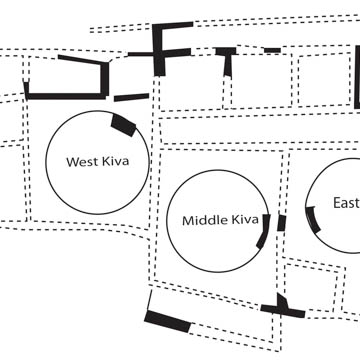The Bluff Great House is a unique Ancestral Puebloan ruin that tells the tale of a distinct regional community and its relationship to the twelfth-century Native American cultural center located in present-day Chaco Canyon. This site helps archaeologists piece together the links between native cliff dwellers, the local elite, and a larger trade network. Yet the true form of the house and connections to Chacoan culture have been obscured by episodes of remodeling during its use and by erosion over time.
Today, the Bluff Great House is a large rubble mound measuring fifty meters long, twenty-eight meters wide, and almost four meters high. It was built between 1075 and 1150 in at least two stages, and remodeled intermittently over the course of the next century until it was finally abandoned by about 1250. The western part of the structure, built of single-coursed, scabbled masonry, seems to have been constructed at a different time than the eastern part, which is built of core-and-veneer and compound masonry. It was three or four stories high, and somewhat rectangular in form, with at least four intramural or blocked-in kivas grouped along the front (south) side. Oriented almost exactly east-west, the bearing of the rear wall lines up with the autumnal equinox.
The Bluff Great House establishes continuity between the many ruins tucked deep into the area’s surrounding sandstone cliffs; excavations reveal that the Great House was the ceremonial focus for these small satellite communities. Evidence of feasting at the Great House, as well as a lack of evidence for certain domestic activities, suggest that the Bluff Great House was not a typical Puebloan residence. Catherine Cameron, an archaeologist at the University of Colorado who has worked extensively on the excavation of the site, has found evidence to suggest that the handful of people who lived here were probably the social elite. Artifacts recovered from the site demonstrate remarkable interactions between other neighboring cultures including the Mesa Verde, Kayenta, and Fremont societies.
Although the site had been occupied since at least 500, it is believed that the Great House was built by people who had recently migrated to the northern San Juan from areas to the south (including regions surrounding Chaco Canyon). The site has a great kiva and a berm, which was probably also built by these migrants. The Bluff Great House is connected to the contemporaneous Chaco culture by a number of architectural features typical of outlying canyon great houses: large rooms; planned, symmetrical layouts; enclosed kivas; and core-and-veneer masonry. The eastern portion of the Great House is most “Chaco-like” and was at least two stories tall, although in some places it may have been up to four stories high. Three of the four kivas on site are found in this eastern section of the Great House but only one has internal features that link it with Chaco-style construction. The other two kivas have features that are typical of the local, northern San Juan type.
Chaco builders are well known for moving earth and modifying the landscape below and around their great houses. Archaeological evidence suggests that the original Bluff Great House builders leveled the construction site before building; the floors of the three excavated rooms along the rear of the site are within a few centimeters of the same depth. The leveling of the site produced the construction materials from which the Great House was shaped. This is unusual for northern San Juan builders but typical of Chaco-era builders.
There are more than forty similar great houses strung across the Northern San Juan region. Together these confirm the far-reaching influence of Chacoan culture. The Bluff Great House is one of the most impressive sites in this regional system and shows that the Chacoan people exerted some level of political and ceremonial influence, if not direct control, over the Northern San Juan for as many as seventy-five years during the late eleventh and early twelfth centuries.
References
Cameron, Catherine. Chaco and After in the Northern San Juan: Excavations at the Bluff Great House. Tucson: University of Arizona Press, 2009.
Cameron, Catherine. “Sacred Earthen Architecture in the Northern Southwest: The Bluff Great House Berm.” American Antiquity 67, no. 4 (2002): 677-695.
Geib, Phil R. “Earthen Architecture at the Bluff Great House Site in SE Utah.” Journal of Field Archaeology 32, no. 4 (2002): 339-352.

